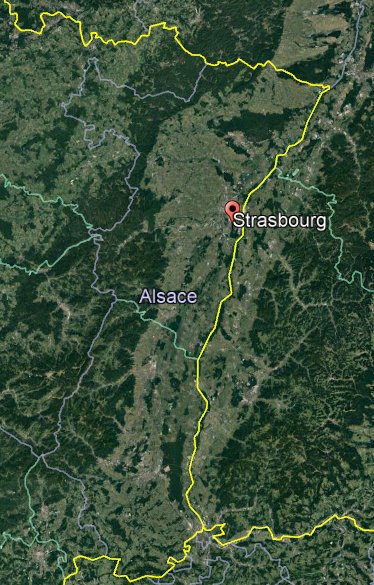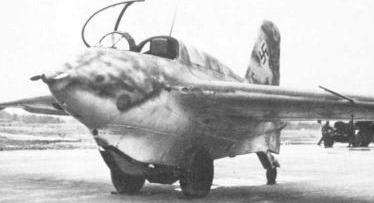ALSACAT-1944-12-27-STRASBOURG-1
An aircraft crew from the 415th US Air Army Force Night Fighters Squadron reported "foo fighters" during a mission over the Bas-Rhin sector in Alsace on December 27, 1944, at 01:45 a.m. They first saw two yellow flame strips flying at the same level as their plane about 1000 meters to their left.
They also saw red fireballs that remained for 10 seconds at about 45 miles away.
After seeing the yellow strips, they had veered to the right, lost altitude, and the features had disappeared from sight.
The ground-based radar station "Blunder" was called to find out if any aircraft were nearby and they answered in the negative.
The crew asked to return to the "Angels 10" area, and they felt what they thought was propeller blast, very distinctly.
Several groups of lights were noticed off their right when they patrolled in the vicinity of Q-9050 and R-1556. These lights formed sharp lines "a bit like arrows."
| Date: | December 27, 1944 |
|---|---|
| Time: | 01:45 a.m. |
| Duration: | ? |
| First known report date: | January 30, 1945 |
| Reporting delay: | 3 days. |
| Department: | Bas-Rhin |
|---|---|
| City: | Strasbourg |
| Place: | From a flying night fighter plane, UFO in the sky. |
| Latitude: | 48.580 |
| Longitude: | 7.743 |
| Uncertainty radius: | 20 km |
| Number of alleged witnesses: | 2 |
|---|---|
| Number of known witnesses: | 1 or 2 |
| Number of named witnesses: | 0 |
| Witness(es) ages: | Adults. |
| Witness(es) types: | US Army night fighter crew. |
| Reporting channel: | Summary in US Army official report. |
|---|---|
| Type of location: | From a flying night fighter plane, UFO in the sky. |
| Visibility conditions: | Night. |
| UFO observed: | Yes |
| UFO arrival observed: | Yes |
| UFO departure observed: | Yes |
| Entities: | No |
| Photographs: | No. |
| Sketch(s) by witness(es): | No. |
| Sketch(es) approved by witness(es): | No. |
| Witness(es) feelings: | Puzzled. |
| Witnesses interpretation: | ? |
| Hynek: | NL |
|---|---|
| ALSACAT: | Unidentified, insufficient information. |
[Ref. us2:] FRED B. RINGWALD, US ARMY AIR FORCE:
The 415th Night Fighter Squadron of the U.S. Air force was formed in February 1943 and it carried out patrols in the Mediterranean and then North-west Europe during World War II.
Through April 1945, the squadron flew patrols and intruder missions, concentrating its attacks on enemy installations, supplies, communications, and troops. It used Bristol Beaufighter British planes at that time.
In December 1944, members of the 415th made multiple reports of what they called "foo-fighters", as recorded in a January 30, 1945 report to Tactical Air Command by intelligence officer Fred Ringwald.
Here are the parts of that report about the sighting in their case file:

|
1. In compliance with paragraph 3 of 1st Incl., the following extracts from the Sortie Reports of various pilots who have encountered the Night Phenomenon are submitted for your information.
[... Other sightings ...]
Night of 26-27 December 1944 - "At 01:45 hrs. saw two yellow streaks of flame flying at same level at approximately 3000 ft. off port side. We also saw red balls of fire that stayed up for 10 seconds approximately 45 miles away. After seeing yellow streaks, made starboard vector, lost altitude and streaks disappeared from view. Called CGI Blunder and asked if any E/A were in vicinity. They answered No. Instructed to return to Angels 10. We felt what was thought to be prop wash; very distinct. Noticed several groups of lights off port while patrolling in vicinity of Q-9050 and R-1556. Lights made distinct lines somewhat like arrows."
[... Other sightings ...]
2. In every case where pilot called CGI Central and asked if there was a Bogey A/C in the area he received a negative answer.
F.B. RINGWALD [Fred B. Ringwald, the unit's S-2 Intelligence Officer.]
Captain, [Illegible]
Intelligence Officer
Note: the report lists several other sightings in Alsace, those have their own case files. It also lists several sightings whose location is unknown to me as they were coded such as "Q-9050", "Q-1378" etc... these location may have been over Alsace, over elsewhere in France, or over Germany. As I did not find the meaning for these locations codes, I cannot include these other sighting in ALSACAT for now.
[Ref. gle1:] GORDON LORE AND HAROLD DENNEAULT:
Another pilot who saw the objects in January angled sharply into them. He said he felt "prop wash" as he zoomed past the "foo-fighters." Ground radar told him there were no other aircraft in the vicinity. He steered straight for a large cloud, determined to lose the UFOs.
Dropping down 2,000 feet, he made a 30 degree turn and emerged from the cloud seconds later. Behind him and in the same relative position followed the "foo-fighters." The lights stalked the plane for a short distance, then disappeared.

|
In the Condon Report [con], Martin D. Altschuler says that Foo Fighters were St Elmo fire. However, it cannot be the correct explanation for the phenomena reported here, suffice to read what St. Elmo fire are in Altschuler's text or elsewhere to realize that it does not appear as yellow streaks nor red balls. Other plasma phenomena such as ball lighting also do not apply.
To me, the crew's description of the "two yellow streaks of flame" might be explained by two meteors - meteors by two is quite rare but not impo0ssible.
Messerschmitt 163 "Komet", as its name suggests, would indeed produce some luminous gleam or streak at night: it was the first rocket plane used in air battles in the world. It reaches 9000 meters of altitude in 2 minutes, or 12000 meters in 3 minutes, can still operate 3 to 4 minutes, and when the fuel is exhausted, the rocket is off and it glides down.

One Me-163 is shown at the USAF Museum at Dayton, Ohio, USA, another is shown at London's Science Museum, U-K. |
From February 1944, Komet were precisely built in the Black Forest, not far from the place of this observation. In July 1944, 16 Komet are operational, their number would increase to 250 at the end of the 1944. Though a brilliant idea, the plane was a disaster in operation, with 80% of them destroyed in explosions of its dangerous fuel on the ground. The pilots damaged their spine at the time of takeoffs. The interceptions of bombers did not go well because the Komet was much faster, and they were often destroyed by P-51 Mustang fighters that protected the bombers once they started to glide down at a lower speed. While more than 400 Komet were built, they only shot down 9 allied bombers, which made Komet one of the less efficient combat plane ever built.
The reported streaks of yellow flames seem compatible with the of Komets.
However, there are issues with such an explanation:
The 2nd Jagdgeschwader (JG) 400 Squadron, the first and only combat unit using the Me-163, was based on the Venlo airfield in Holland and carried out little action before it was moved to Brandis, near Leipzig in July 1944. At Brandis, the JG 400 experienced its strongest operational activity on September 28, 1944, when it was able to take off 9 Me-163 to intercept American bombers. It was daylight, and the story shows that there seems to have been no test of this airplane at night. The only Luftwaffe night test field was Estelle Retime.
Mano Ziegler, test pilot and then pilot of Me-163 at the JG 400 had been questioned about the possibility of night flights of the Me-163 and had replied: "Trying to land at night would put you in small pieces over the whole country!" (Ziegler p.113) In fact, the "Komet" has no landing light, which is equivalent, given its characteristics, to sure death in the case of an attempt to land at night.
In addition, the Me-163's range was only 25 miles under good conditions, so the JG 400 flew only in the Leipzig region.
As for the red balls, the possibility that immediately comes to mind is one or more other planes.
This idea is reinforced by the mention of "prop wash; very distinct". But the radar station said there was none there.
I checked in another Aslatian Foo-Fighter case various other potential explanations that I will no republish here; none seems very convincing to me.
In this context, and with the brevity of the original report, it is not unreasonable to consider that the crew was really thinking that they observed some sort of airplane. A UFO or flying saucer context did not exist to them, so a report and description of a light would not comprise any elements that would suggests they did not think it was some sort of aircraft of human construction.
Unidentified, insufficient information.
* = Source is available to me.
? = Source I am told about but could not get so far. Help needed.
| Main author: | Patrick Gross |
|---|---|
| Contributors: | None |
| Reviewers: | None |
| Editor: | Patrick Gross |
| Version: | Create/changed by: | Date: | Description: |
|---|---|---|---|
| 0.1 | Patrick Gross | January 24, 2018 | Creation, [usa1], [gle1]. |
| 1.0 | Patrick Gross | January 24, 2018 | First published. |